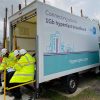Why Some UK Full Fibre Builds Take Longer to Go Live Than Others

A large number of network operators are currently busy building gigabit-capable Fibre-to-the-Premises (FTTP) broadband ISP infrastructure across the UK, but some of them appear to take significantly longer than others to go live in similar areas. In this article, we explore the reasons why.
More and more people are starting to have a similar experience. You’ve waited years for optical fibre to reach your area, and then, all of a sudden, the engineers are outside your house and that giddy feeling of excitement – often tempered by some frustration at the local disruption – soon builds.
Nevertheless, as quickly as that excitement built the first time you saw the engineers, then so too does it deflate once you realise that the new network isn’t live yet (i.e. immediately post-build), and probably won’t be ready for some considerable time. In addition, it doesn’t help that many operators leave the crucial detail of an estimated “live” date out of their pre-build leaflet drops, which are typically quite vague.
Advertisement
However, experiences do vary, with some operators putting new fibre infrastructure live only weeks after the completion of new streets (e.g. Netomnia), while in other cases it could be many months, or even as long as 1-2 years, before you’re able to actually get the new service installed (after the physical build has completed in your street).
Why the time difference?
For the purposes of this article, we’ve only considered operators that are deploying into more urban environments (towns and cities), which makes it easier to compare the different approaches between those working at a similar scale and in similar areas. By comparison, rural builds may involve different approaches and cover considerably fewer premises over a wider area, thus the timescales and challenges involved seem more variable.
Suffice to say, there can be a number of reasons why some operators are able to go live more quickly than others. We’ve summarised some of the most common examples below, although this should not be considered an exhaustive list as there may be many other complex issues to consider.
➤ Vertically Integrated Operators Move Faster
Operators that are both the builders of their own network and also the retail ISP don’t need to worry about securing support from other providers, which means they can go live fairly quickly. By comparison, operators that build networks with a view to offering access to comms providers via wholesale have to allow time for ISPs to support such builds, as well as to setup their networks and ordering systems etc.
CityFibre is a good example of an operator where some delays have occurred because completed builds in some areas had to wait for supportive ISPs to be ready before going live (here).
➤ Databases Out of Sync
One other common problem can occur when broadband ISP availability checkers, which tend to be the first port of call before consumers place an order, are not as up-to-date with the latest build completions as they should be. Once again, this isn’t such an issue for vertically integrated operators, but it can become a problem for other ISPs.
Put another way, sometimes the consumer ISP may simply be slow to download and apply the latest coverage update from the network builder’s database, or they might need longer due to juggling support for several networks (some of which may exist in the same area). Often such issues are resolved within weeks, rather than months, but this can add to the delays before potential customers are able to order.
➤ Different Build Principles
Some operators building in dense urban areas often like to achieve a good level of coverage before they go live, which can avoid the difficulty of promising too much before they’ve actually delivered anything. The latter could lead to a more negative perception of the brand, while also frustrating locals who might be expecting the service to arrive much sooner than it otherwise would.
The flip side of this is that operators are already required to inform residents before they start building in their area, which makes managing consumer expectations much harder, as many people will naturally assume that they’ll be able to order the service just as soon as the local build is complete.
➤ Different Build Methods
Typically, operators that are able to harness lots of existing infrastructure (cable ducts and poles) can often run fibre to your home much more quickly than those that may need to build from scratch. In addition, operators that build most of their fibre underground might spend significantly longer and much more money on the street works than those that simply opt to erect new telegraph poles and overhead fibre.
➤ Networks Are Bigger Than One Street
An operator might have built fibre down your street, but that doesn’t necessarily mean they’ve connected it up to the rest of their infrastructure, yet. Furthermore, it takes time to secure or build the necessary data centres, wayleaves (land/property access agreements), backhaul capacity (a particularly tedious problem for some) and street cabinets to help run the network, which may need to be setup quite far from your area.
As a result it can still take a fair bit of time before your street, or your particular part of the area’s fibre build, is connected into the wider network and then linked back to the necessary processing or distribution points. Put another way, your street’s ability to go live may be reliant upon the build being completed in other nearby streets.
However, some operators take a different approach, which means they effectively get everything ready BEFORE they start building to individual streets (more time and money spent upfront – pre-build). The result is that they’re often able to go live much sooner, but this doesn’t change the fact that deploying across an entire town or city will be a slow process, no matter which approach you take.
➤ Electricity
Often an operator might have got much of their physical network complete, but that doesn’t matter much if they can’t feed the distribution points and other areas with electricity. Power supplies involve complex negotiations and separate work by power companies, which doesn’t always go according to plan.
➤ Permits and Road Crossings
Sometimes all that may be left for a large section of the network to be completed is to cross a road or two (i.e. linking it into the wider infrastructure). But if that road happens to be particularly important to the local area or highway authority, then it may complicate the build and take longer to gain approval. In fact, securing the necessary notices and permits for various work often causes administrative delays.
➤ Blocked Ducts and Unexpected Obstacles
Before a build begins the operator will conduct detailed engineering surveys in order to help them map and plan out how best to conduct the deployment. But such surveys won’t pick up everything and sometimes operators can run into unexpected problems, such as blocked or damaged cable ducts, which may require complex street works to resolve.
Often such issues tend to result in a requirement for more permissions and more planning to take place, as well as the work to rectify the problem itself, which can significantly add to the time needed to fully complete a section of the new network.
One other issue that can crop up may involve wildlife, which could either cause danger to engineers (e.g. Adders and Wasps nests) or create complicated challenges (e.g. the need to move or avoid disrupting a protected species of animal, such as otters or honey bees). The latter may, in some cases, add significant delays while the problem is assessed.
➤ Complaints
Not everybody greets the construction of new fibre with the same glee as readers of ISPreview.co.uk. Some will bemoan the noise and disruption, which is understandable. Nevertheless, if enough complaints flood in to the local authority then that could cause delays or possibly even require changes to the rollout plan, all of which can slow things down and add costs.
In some cases the demands for change may cause part of the build to become uneconomic (e.g. placing the fibre underground, rather than overhead), which could result in an operator pulling out and going elsewhere.
➤ Criminal Damage & Theft
Vandalism and theft are a frequent hazard for street works, as many engineers soon discover. Apparently, there’s nothing that thieves won’t try to steal, if given half the chance. Procedures exist to reduce the exposure to this, and often it’s only smaller items that get stolen or damaged, but occasionally bigger vehicles and rarer tools may be impacted. In those cases it can take time to go through the usual motions with police and to secure a replacement.
Suffice to say, there are a lot of reasons why some FTTP builds may take significantly longer than others, which can vary between both operators and locations. We’ve only really scratched the surface with our above simplification, but hopefully it’s enough to give you a reasonable idea of some causes.
Advertisement
Mark is a professional technology writer, IT consultant and computer engineer from Dorset (England), he also founded ISPreview in 1999 and enjoys analysing the latest telecoms and broadband developments. Find me on X (Twitter), Mastodon, Facebook, BlueSky, Threads.net and Linkedin.
« Voneus Target 10,500 Pembrokeshire Homes for FTTP Broadband























































Gigaclear are starting to put CABS up in my areas now, they have put little signs on the telegraph poles stating overheated fibre optic cables. I expect it’ll take a while for them to reach my house and go live. But it’s exciting when you see physical progress of a build. If I see any of the workers I may ask them roughly when do they think they will reach me.
I’ve spotted Cityfibre digging the streets in Plymouth, my partner told me that the area where we live was dug up around 18 months ago. It’s a little frustrating that we can’t get some sort of idea of when they’re going to start going live. We’re out of contract with Virgin but reluctant to change providers (we also have Openreach FTTP in the area). Best estimate I’ve had so far was from Giganet suggesting that we could place an order in July.
We’re finding our Virgin service isn’t great, the latency is fairly poor (although download and upload speeds are fairly close to what we pay for) but the last thing we want is to be tied into a 2 year contract with a new provider via Openreach only to find that 3 or 4 months into the contract we can get Cityfibre (unless it’s possible with a provider such as Zen or Vodafone to get FTTP via Openreach and then transfer over to FTTP via Cityfibre without having to pay for 20 odd months of service just to change FTTP wholesale providers).
CityFibre release on a cabinet by cabinet basis to ISPs. This is usually about 350-400 home areas. A cab area can take about 12 weeks to complete. Then another month for various other things to happen to allow for customers to order.
Some cities take longer to get ISPs on board hence longer time frames in places like Plymouth.
Try a monthly tariff if you think connection is coming your way fairly soon? This is what a lot of people have recommended in B4RNland. https://freeola.com/broadband/short-term-broadband.php
I’ve been waiting for this too and ended up getting gigabit with virgin (really wanted city fibre and not virgin) Has been pretty much no updates from cityfibre in two years. I’ve even contacted them with no good reply too
Frustrating ! Now I have a 18th month contract with Virgin.
And the reply on their website to check says :
We’re still building in your area.
Unfortunately it looks like we don’t have permission from your landlord to install Full Fibre in your property. Register your interest and we’ll be in touch when you can connect your home.
No idea what this even means 🙂 My landlord has not been contacted.
Where do those numbers come from, Pw?
A primary node is about 480 premises passed. Most cabinets are secondary nodes at 60-ish (might stop at 64, might max out at 128, can’t remember) premises passed?
Areas are not released to ISPs on a cabinet by cabinet basis. On the older CityFibre products ISPs rent colocation space in the FEX and pay for connection to each OLT, each OLT serving many primary nodes.
@An Engineer: VM’s FTTP network uses the VHUB which serves 3,000 premises. Connected to the VHUB are distribution cabinets which serve, I think, 48 or 96 premises. The distribution cabinets are passive, so it’s the VHUB and ONTs at customer premises which require power.
@Roger_Gooner Indeed but in no way relevant to the discussion on CityFibre.
I’ve read the VM guide too. You missed OUT the layer of cabinets in between, for the Mustang overbuild these are mostly POPA inverted nodes, that serve up to 512 premises and aggregate multiple distribution cabinets.
I had a survey for a line – Surveyor said all was good after he put the fibre through the ducts – and then our existing internet started to have disconnects – I am then told there is a collapsed duct and there were ECC”s – they have now just found another 5 blockages months down the line.
So you never know.
This doesn’t make sense on any level.
The surveyor wouldn’t be putting fibre into the ducts, they survey not install, and if it did go into the ducts that’d be the construction done.
Five blockages wouldn’t just appear out of nowhere. Five blockages on a DIA route is highly unlikely given they mostly use existing fibre now let alone an FTTP route – both are now proven out pretty close to the premises being served, FTTP especially: it’s just a drop from CBT to home/business.
No idea of the motivation behind posting but this seems like fiction.
I found that cityfibre appears to take rather long and prefers to go live in entire areas rather than on a per street basis.
Early on they have usually done some pretty extensive build towards local homes and businesses before the fibre exchange and core network are ready. Once those are done it’s usually pretty swift when they actually build out to homes.
Digging nearby or even in the street isn’t the same as the build to homes. They can be separate phases of the construction separated by quite a long period.
Twice in past year, in Bournville, Birmingham, OpenReach have informed me that FTTH is close at hand – and that I will be able to formally order the service within 12 weeks. Then, on each occasion, the OpenReach website back-peddals, stating that FTTH isn’t available in our area yet.
Oh dear. It seems some of the above commentators haven’t read this excellent article and jumped straight to comments.
For 90% of articles Mark could sadly save a lot of time by writing generic bullet points then ending with ‘and now over to the experts in the comments’.
Database out of sync is a pure lazyness from data teams, considering that most developers submit their addresses to Ordnance Survey several months before a property is handed over
Also not mentioned: wayleaves and engagement with landlords, a verbal agreement is one thing but to get to the point in which a company can install their cables in a building can take a very long time even if all other elements have been cleared
Wayleaves are already mentioned.
It’s really not likely to be laziness. A company makes a huge capital investment and then can’t be bothered to do the data work to make a return on it? Implausible.
It appears that openreach are picking the low hanging fruit first. We are fed by overhead poles and the area was connected last year. Just round the corner they are fed by underground lines and have not been connected.
Must be at least 3 years since City Fibre had roads closed all over the place near me; I can’t find any evidence of the service being live yet. I’ve signed up for another 18 months with Virgin…hopefully it will be live by then.
My area in Fulham is a case study of all this. My street is apparently due Community Fibre. Their website has been saying coming ‘in a few months’ for my address since October on their website. Three months ago they got a permit for roadworks in my street for four days for unblocking ducts. Done in one day. No more news. Then six weeks ago did the next street same way. Last September they put a flier in my letterbox saying ready for connection! Called them then immediately. Installer arrived two days later and said couldn’t figure out how to run a cable/wire from the telegraph pole in another adjoining street to my house. Mine was closest to said pole but they had leafleted my whole street to say it was available. Eventually they gave up.
Meanwhile the street on the other side of my home represents the start of a square mile of G network. They’ve been digging up streets for a year. In some cases around Munster Road they’ve dug up more than once. Every resident I talk to is sick of the disruption. They close down whole streets for over a week and so no one can even park there. To say they might then do a six hour day is stretching it.
Tail of two approaches, both leaving dissatisfied residents.
Meanwhile no one has any idea when they will be connected, G Network or Community Fibre. But, Sky keeps showed tailored local ads saying G Network is live.
Unfortunately leaflet companies aren’t the brightest when following address lists
Openreach have done ground work for FTTP in my parents’ street, progress has come to a halt until the telegraph poles installed in the 1960s are replaced.
I’ve had this exact issue and thought it was just because we’d been forgotten about. Moved to an area of Milton Keynes which was the first to receive Cityfibre’s Gigabit broadband, except my brand new street was left off (literally every other street has it). Nearly a year ago they finally installed the cabling and cabinets on our street… But since then, crickets! No sign whatsoever of when it actually goes live. Still stuck with Openreach until we hear anything mre.
A lot of it appears to be down to poor planning. You can make an estimate of how many blocked ducts you are likely to encounter etc. No plan will be a 100% accurate. You build in contingency for that though
Another issue is they are all but useless at keeping potential consumer informed of progress or lack of it at best you well get a coming to your area soon which translated might mean from a few weeks to a few years
You hit the nail on the head Bob, they need to communicate.
Cityfibre’s checker sat at planned for 2 years, now its apparently coming to my area, emails sent were never given any kind of estimated date in return.
So the company is either disorganised or they deliberately dont want to share their schedule which is poor going. If its going to take two years, then just tell me, dont just leave me hanging there wondering whats happened.
I’m a little confused at “operators are already required to inform residents before they start building in their area”.
Both Openreach and Virgin are building in my area (CityFibre are yet to start but in scope), no evidence the residents were informed of any of this.
If I wasn’t regularly checking one.network, I would be none the wiser who is doing what. Most of the teams don’t even put up the signs saying “work on behalf of”.
If they’re digging up the street outside your house, then you’ll usually get a notice, but if it’s permitted (PD) or minor development then you might not (e.g. somebody fitting a Toby box to an existing network or deploying a new pole). But not all contractors do things the right way.